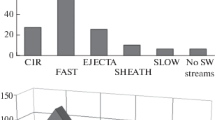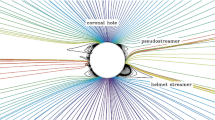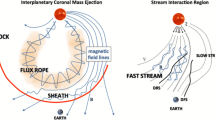Abstract
The paper considers the classification of solar wind streams in magnetohydrodynamic parameters (MHD-types); combinations of proton speed, density, temperature, and magnetic field strength, in addition to the classical solar wind separation into high-speed streams from coronal holes, transient streams of coronal mass ejections, and the slow solar wind from the streamer belt. Two classifications of solar wind properties were compared for the events in August 2010 and May 2011, when one could observe the interaction of two coronal mass ejections and a coronal mass ejection with a high-speed solar wind stream from the coronal hole, respectively. It is shown that the classical description of a large-scale structure of wind streams (the ion wind composition especially) in scales of hours and days allows one to determine the type and source of streams, whereas the MHD-parameters allow one to more accurately describe the small-scale structure (in minutes), especially in the cases of several streams interaction in the heliosphere. The detailed study of a small-scale structure of stream interaction regions provides the information required for developing MHD-models describing the processes of propagation and interaction of streams in the heliosphere and for predicting their geoefficiency.







Similar content being viewed by others
REFERENCES
Parker, E.N., Interplanetary Dynamical Processes, New York: Interscience, 1963; Moscow: Mir, 1965.
Richardson, I.G. and Cane, H.V., Near-Earth solar wind flows and related geomagnetic activity during more than four solar cycles (1963–2011), J. Space Weather Space Clim., 2012, vol. 2, A02.
Feldman, U., Landi, E., and Schwadron, N.A., On the sources of fast and slow solar wind, J. Geophys. Res.: Space Phys., 2005, vol. 110, A07109.
Xu, F. and Borovsky, J.E., A new four-plasma categorization scheme for the solar wind, J. Geophys. Res.: Space Phys., 2015, vol. 120, pp. 70–100.
Cane, H.V. and Richardson, I.G., Interplanetary coronal mass ejections in the near-Earth solar wind during 1996–2002, J. Geophys. Res.: Space Phys., 2003, vol. 108, 1156.
Galvin, A.B., Popecki, M.A., Simunac, K.D.C., et al., Solar wind ion trends and signatures: STEREO PLASTIC observations approaching solar minimum, Ann. Geophys., 2009, vol. 27, no. 10, pp. 3909–3922.
Richardson, I.G. and Cane, H.V., Near-Earth interplanetary coronal mass ejections during solar cycle 23 (1996–2009): Catalog and summary of properties, Sol. Phys., 2010, vol. 264, no. 1, pp. 189–237.
Mason, G.M., Desai, M.I., and Li, G., Solar cycle abundance variations in corotating interaction regions: Evidence for a suprathermal ion seed population, Astrophys. J. Lett., 2012, vol.748, no. 2, L31.
Gopalswamy, N., Mäkelä, P., Akiyama, S., Xie, H., Yashiro, S., and Reinard, A.A., The solar connection of enhanced heavy ion charge states in the interplanetary medium: Implications for the flux-rope structure of CMEs, Sol. Phys., 2013, vol. 284, no. 1, pp. 17–46.
Yermolaev, Yu.I., Nikolaeva, N.S., Lodkina, I.G., and Yermolaev, M.Yu., Relative occurrence rate and geoeffectiveness of large-scale types of the solar wind, Cosmic Res., 2010, vol. 48, no. 1, pp. 1–30.
Hundhausen, A.J., Coronal Expansion and Solar Wind, Berlin: Springer, 1972; Moscow: Mir, 1976.
Mullan, D.J., Sources of the solar wind: What are the smallest-scale structures?, Astron. Astrophys., 1990, vol. 232, no. 2, pp. 520–535.
Tu, C.Y. and Marsch, E., MHD structures, waves and turbulence in the solar wind: Observations and theories, Space Sci. Rev., 1995, vol. 73, nos. 1–2, pp. 1–210.
Šafránková, J., Němeček, Z., Cagaš, P., Přech, L., Pavlů, J., Zastenker, G.N., Riazantseva, M.O., and Koloskova, I.V., Short-scale variations of the solar wind helium abundance, Astrophys. J., 2013, vol. 778, no. 1, id 25.
Zastenker, G.N., Koloskova, I.V., Ryazantseva, M.O., Yurasov, A.S., Šafránková, J., Němeček, Z., Přech, L., and Cagaš, P., Observation of fast variations of the helium-ion abundance in the solar wind, Cosmic Res., 2014, vol. 52, no. 1, pp. 25–36.
Hundhausen, A.J., Gilbert, H.E., and Bame, S.J., Ionization state of the interplanetary plasma, J. Geophys. Res., 1968, vol. 73, no. 17, p. 5485.
Burlaga, L.F., Plunkett, S.P., and St. Cyr, O.C., Successive CMEs and complex ejecta, J. Geophys. Res.: Space Phys., 2002, vol. 107, no. A10, pp. SSH-1-1–SSH-1-12.
Burlaga, L., Berdichevsky, D., Gopalswamy, N., Lepping, R., and Zurbuchen, T., Merged interaction regions at 1 AU, J. Geophys. Res.: Space Phys., 2003, vol. 108, no. A12, 1425.
Rouillard, A.P., Lavraud, B., Sheeley, N.R., Davies, J.A., Burlaga, L.F., Savani, N.P., Jacquey, C., and Forsyth, R.J., White light and in situ comparison of a forming merged interaction region, Astrophys. J., 2010, vol. 719, no. 2, pp. 1385–1392.
Liu, Y.D., Luhmann, J.G., Mostl, C., Martinez-Oliveros, J.C., Bale, S.D., Lin, R.P., Harrison, R.A., Temmer, M., Webb, D.F., and Odstrcil, D., Interactions between coronal mass ejections viewed in coordinated imaging and in situ observations, Astrophys. J. Lett., 2012, vol. 746, no. 2, id L15.
Liu, Y.D., Yang, Z., Wang, R., Luhmann, J.G., Richardson, J.D., and Lugaz, N., Sun-to-Earth characteristics of two coronal mass ejections interacting near 1 AU: Formation of a complex ejecta and generation of a two-step geomagnetic storm, Astrophys. J. Lett., 2014, vol. 793, no. 2, id L41.
Temmer, M., Vršnak, B., Rollett, T., Bein, B., de Koning, C.A., Liu, Y., Bosman, E., Davies, J.A., Möstl, C., Žic, T., Veronig, A.M., Bothmer, V., Harrison, R., Nitta, N., Bisi, M., Flor, O., Eastwood, J., Odstrcil, D., and Forsyth, R., Characteristics of kinematics of a coronal mass ejection during the 2010 August 1 CME–CME interaction event, Astrophys. J., 2012, vol. 749, no. 1, Р. 57.
Rodkin, D., Zhukov, A.N., Goryaev, G., Slemzin, V., Shugay, Y., and Veselovsky, I., Single ICMEs and complex transient structures in the solar wind in 2010–2011, Sol. Phys., 2018, vol. 293, no. 5, id 78.
Pagano, P., Reale, F., Orlando, S., and Peres, G., MHD evolution of a fragment of a CME core in the outer solar corona, Astron. Astrophys., 2007, vol. 464, pp. 753–760.
Pagano, P., Mackay, D.H., and Poedts, S., Magnetohydrodynamic simulations of the ejection of a magnetic flux rope, Astron. Astrophys., 2013, vol. 554, id A77.
Wold, A.M., Mays, M.L., Taktakishvili, A., et al., Verification of real-time WSA-ENLIL+Cone simulations of CME arrival-time at the CCMC from 2010 to 2016, J. Space Weather Space Clim., 2018, vol. 8, A17.
Yermolaev, Yu.I., Nikolaeva, N.S., Lodkina, I.G., and Yermolaev, M.Yu., Catalog of large-scale solar wind phenomena during 1976–2000, Cosmic Res., 2009, vol. 47, no. 2, pp. 81–94.
Dmitriev, A.V., Suvorova, A.V., and Veselovsky, I.S., Statistical characteristics of the heliospheric plasma and magnetic field at the Earth’s orbit during four solar cycles 20–23, in Handbook on Solar Wind: Effects, Dynamics and Interactions, Johannson, H.E., Ed., New York: Nova Science, 2009, pp. 81–144.
Vršnak, B., Žic., T., Vrbanec, D., et al., Propagation of interplanetary coronal mass ejections: The drag-based model, Sol. Phys., 2013, vol. 285, nos. 1–2, pp. 295–315.
Mays, M.L., Taktakishvili, A., Pulkkinen, A., et al., Ensemble modeling of CMEs using the WSA-ENLIL+Cone model, Sol. Phys., 2015, vol. 290, no. 6, pp. 1775–1814.
ACKNOWLEDGMENTS
The authors express their deep gratitude to the research teams of SDO/AIA, SDO/HMI, ACE and OMNIWeb for providing access to the data.
Author information
Authors and Affiliations
Corresponding author
Additional information
Translated by Yu. Preobrazhenskii
Rights and permissions
About this article
Cite this article
Rodkin, D.G., Kaportseva, K.B., Lukashenko, A.T. et al. Large-Scale and Small-Scale Solar Wind Structures Formed during Interaction of Streams in the Heliosphere. Cosmic Res 57, 18–28 (2019). https://doi.org/10.1134/S0010952519010088
Received:
Revised:
Accepted:
Published:
Issue Date:
DOI: https://doi.org/10.1134/S0010952519010088




